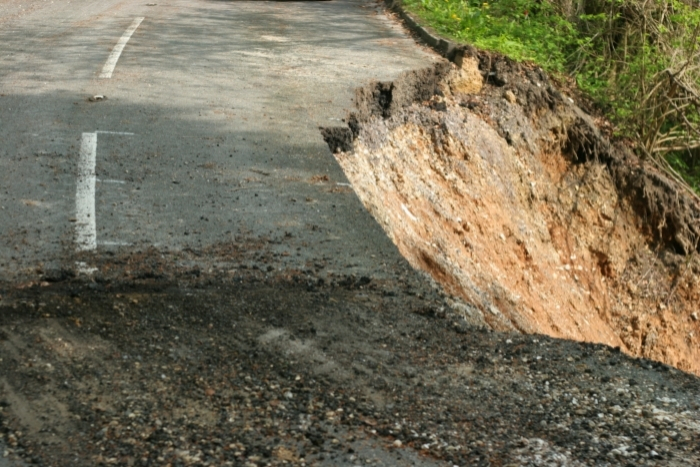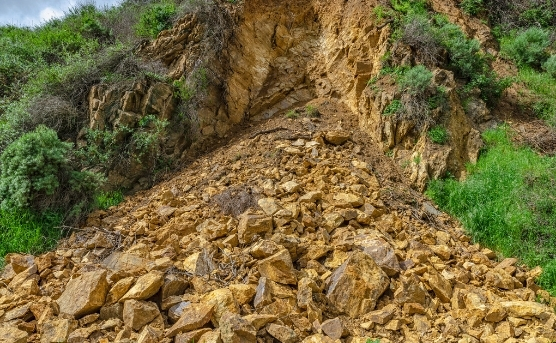Landslides
Disasters and Emergencies
Landslides and Mudflows
Landslides occur in all U.S. states and territories, and usually strike without warning. The force of rocks, soil, or other debris moving down a slope can devastate anything in its path. Landslides can be activated by:
- Alternate freezing or thawing
- Earthquakes
- Fires
- Steepening of slopes by erosion or human modification
- Storms
- Volcanic eruptions
Landslide problems can be caused by land mismanagement, particularly in mountain, canyon and coastal regions. In areas burned by forest and brush fires, a lower threshold of precipitation may initiate landslides. Land-use zoning, professional inspections, and proper design can minimize many landslide, mudflow and debris-flow problems.

Know what to do before, during, and after a landslide.

Recognize landslide warning signs.
BEFORE, DURING, & AFTER A LANDSLIDE
BEFORE A LANDSLIDE OCCURS
Get a ground assessment of your property.
Your county geologist or county planning department may have specific information on areas vulnerable to land sliding. Consult a professional geo-technical expert for opinions and advice on landslide problems and on corrective measures you can take.
Minimize home hazards.
- Plant ground cover on slopes and build retaining walls.
- In mudflow areas, build channels or deflection walls to direct the flow around buildings.
- Remember: If you build walls to divert debris flow and the flow lands on a neighbor’s property, you may be liable for damages.
Learn to recognize the landslide warning signs.
- Doors or windows stick or jam for the first time.
- New cracks appear in plaster, tile, brick, or foundations.
- Outside walls, walks, or stairs begin pulling away from the building.
- Slowly developing, widening cracks appear on the ground or on paved areas such as streets or driveways.
- Underground utility lines break.
- Bulging ground appears at the base of a slope.
- Water breaks through the ground surface in new locations.
- Fences, retaining walls, utility poles, or trees tilt or move.
- You hear a faint rumbling sound that increases in volume as the landslide nears. The ground slopes downward in one specific direction and may begin shifting in that direction under your feet.
Make evacuation plans.
- Plan at least two evacuation routes since roads may become blocked or closed.
- Develop an emergency communication plan.
Insurance
Mudflow is covered by flood insurance policies from the National Flood Insurance Program (NFIP). Flood insurance can be purchased through a local insurance agency.
DURING A LANDSLIDE EVENT
If inside a building
- Stay inside.
- Take cover under a desk, table, or other piece of sturdy furniture.
If outdoors
- Try and get out of the path of the landslide or mudflow.
- Run to the nearest high ground in a direction away from the path.
- If rocks and other debris are approaching, run for the nearest shelter such as a group of trees or a building.
- If escape is not possible, curl into a tight ball and protect your head.
Sinkholes
A sinkhole occurs when groundwater dissolves a vulnerable land surface such as limestone, causing the land surface to collapse from a lack of support.
AFTER THE GROUND STOPS MOVING
- Stay away from the slide area. There may be danger of additional slides.
- Check for injured and trapped persons near the slide area. Give first aid if trained.
- Remember to help your neighbors who may require special assistance: infants, elderly people, and people with special needs.
- Listen to a battery-operated radio or television for the latest emergency information.
- Remember that flooding may occur after a mudflow or a landslide.
- Check for damaged utility lines. Report any damage to the utility company.
- Check the building foundation, chimney, and surrounding land for damage.
- Replant damaged ground as soon as possible since erosion caused by loss of ground cover can lead to flash flooding.
- Seek the advice of geo-technical expert for evaluating landslide hazards or designing corrective techniques to reduce landslide risk.